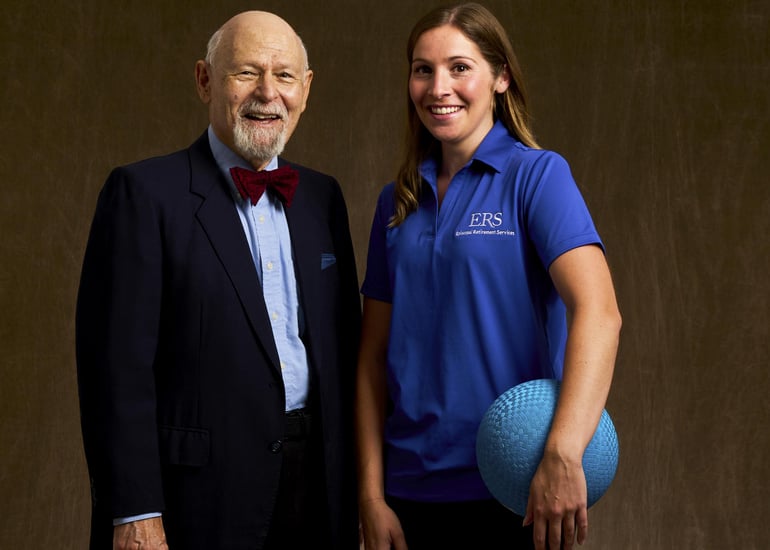
Wellness Director Chloe Hough with Deupree House resident and Tai chi instructor Michael Porte.
January is National Personal Trainer Awareness Month, and our very own Wellness Director Chloe Hough, who guides residents through workouts in person and through our #WellnessWednesday online exercises, has some advice about working out.
She also talked with us about an issue that's close to her (pardon the pun) ... heart: Women's heart health. February is American Heart Month, and Chloe is already preparing for Go Red Day on Friday, Feb. 3. That day promotes awareness of heart health and stroke in women. Here's our Q&A with her ...
Ways to work out for heart health
Question: February is American Heart Month. What exercises or activities would you recommend for people wanting to strengthen that important muscle? Anything they should beware of when doing these exercises, such as how to tell if they’re overdoing it?
Chloe: First, you should always consult your physician before beginning a new exercise program. The American Heart Association recommends at least 150 minutes of moderate-intensity aerobic activity, or 75 minutes of vigorous aerobic activity per week. You can also do a combination of both. One method I use to gauge the intensity level of exercise is the Talk Test. In a moderate-intensity workout, you should be able to hold a breathy conversation while doing the exercise. At a vigorous pace, your effort is so much that it would be a challenge to hold an entire conversation.
The AHA also recommends including at least two days of strength training per week. This can range from bodyweight exercise, to resistance bands, dumbbells, etc. You want to work the major muscle groups of the body that do the most work for you throughout the day. Start slowly and progress over time. There is a difference between muscle fatigue and pain. I always tell people there are a million ways to work the same muscle group; you just have to find the one that is most appropriate for you.
Always be sure to do a warm-up and cool-down, with stretching before and after exercise. It will lessen the risk of injury and make your workout more successful. The key is to always listen to your body. The saying “no pain, no gain” is not necessarily accurate. It should be more like “no fatigue, no gain,” but that doesn’t have the same ring to it. Overall, the key is to move more, and sit less!
Heart and Stroke Awareness
Q: You recently reminded us that Friday, February 3, is National Go Red Day, when people are encouraged to wear red, to raise awareness for heart health and stroke among women. What would you like to tell people, especially women, about the risk of heart disease and stroke? And what do you recommend they do to lessen the likelihood of strokes or heart attacks?
Chloe: The reason the AHA has a special day dedicated to women’s heart health and stroke awareness is because women are impacted greatly, and differently than men. Heart disease, which includes stroke, kills 1 in 3 women. It is the No. 1 killer of women, killing more than all forms of cancer combined. Things like pregnancy, menopause and birth control can impact women’s risk.
There are significant biological differences between men and women. Because of this, heart attack symptoms can vary. The most common symptoms are the same as with men, including chest pain. However, it is important to know that women are more likely to also experience other symptoms like shortness of breath, nausea or vomiting, and back or jaw pain. (A list of symptoms of heart attack and stroke can be found here. If these warning signs are present, call 911.)
Women also face a higher risk of stroke than men, with 55,000 more women having a stroke each year than men.
Women also face a higher risk of stroke than men, with 55,000 more women having a stroke each year than men. Among women, black women have the highest prevalence of stroke. Stroke risk increases in women who are pregnant, have preeclampsia (a complication of pregnancy), take birth control, use hormone replacement therapy, or have atrial fibrillation. Be sure to know the warning signs of stroke with the acronym FAST (Face drooping, arm weakness, speech difficulty, and time is of the essence — so call 911).
So what can we do to lessen our risk? First thing is to understand your risk factors. Understanding your blood pressure levels is very important in reducing risk of heart disease and stroke. Talk with your healthcare professionals for the safest medication options and have your blood pressure checked regularly. You should also talk to your health care professional about your blood sugar levels and cholesterol levels. You will want to discuss your family history with your physician. Some other recommendations include quitting smoking. Eat heart-healthy foods low in saturated and trans fat and salt. Eat more fruits and vegetables, fish, nuts, and legumes. Maybe even try eating a meal without meat. Limit sugar-sweetened drinks and red meat. Research is showing stress management is increasingly important to lessen the risk of heart disease and stroke. Learning stress management techniques can help improve both physical and mental health. And finally, make sure you are getting enough sleep!
You can learn more about this and so much more by visiting GoRedforWomen.Org.
Why not take some time to learn more about Deupree House? If you are considering the move to independent living, our retirement community welcomes you to take a closer look and learn what this type of lifestyle could mean to you.













